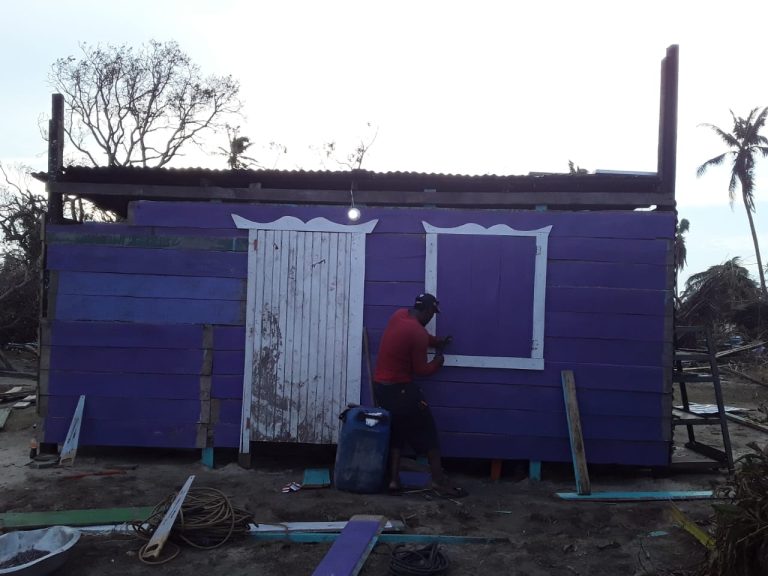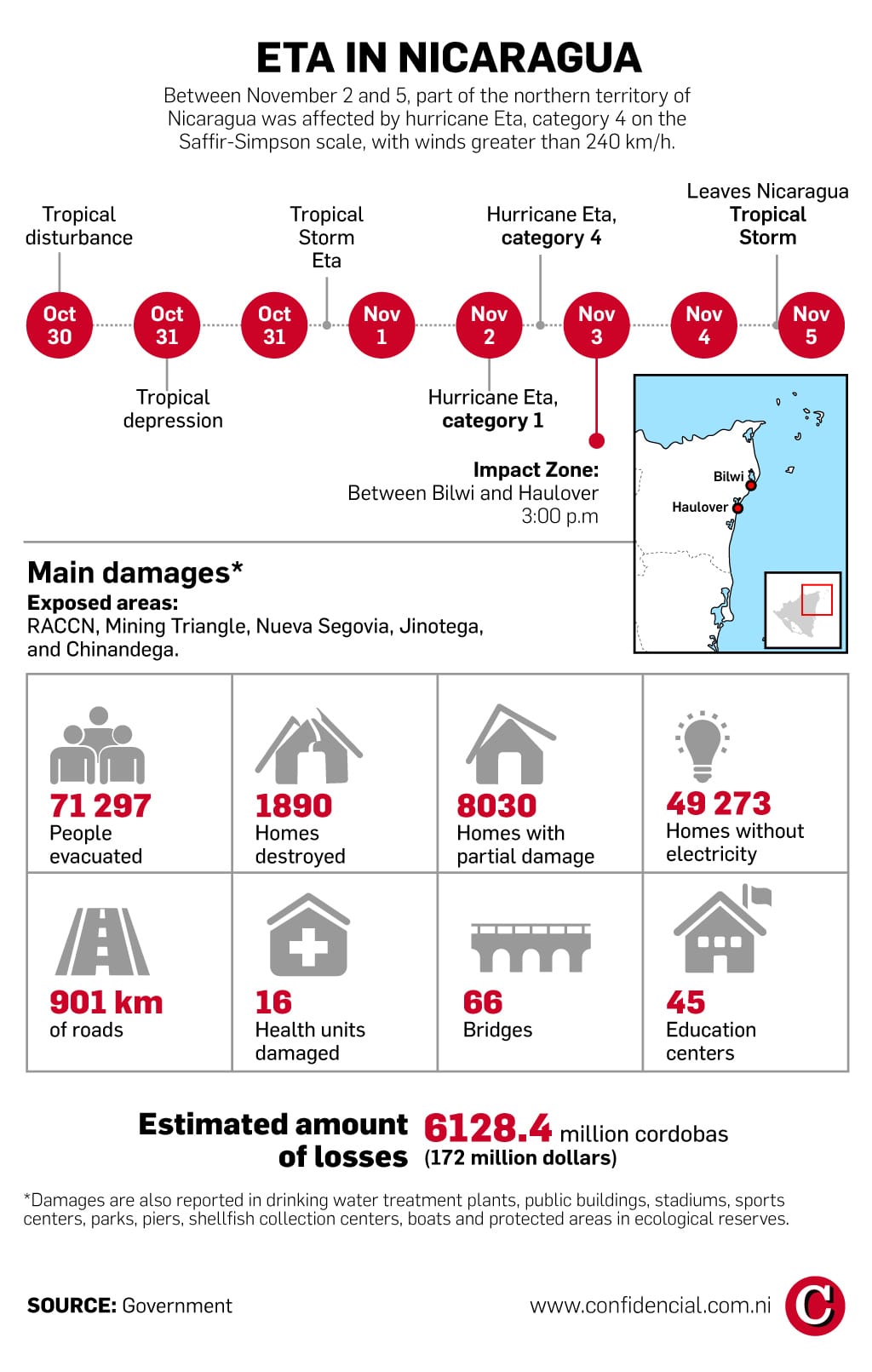17 de noviembre 2020

Nicaragua: Public Employees Hindered from Traveling to USA

PUBLICIDAD 1M
PUBLICIDAD 4D
PUBLICIDAD 5D
More than 47,000 people relocated to 325 shelters during the passage of Eta; the Government requests help after criminalizing solidarity

A man in Wawa Bar tries to rebuild his house with wood that hurricane Eta left scattered. Photo: Courtesy.
The damage caused by Hurricane Eta — which entered the Caribbean coast on November 3 as a category 4 natural phenomenon, with winds of 240 kilometers per hour — is estimated at 172 million dollars, according to the Government of Daniel Ortega and Rosario Murillo. The regime denies the loss of human life, despite the fact that two deaths have been reported by residents of the area.
In a preliminary report released through government-related media, the regime estimates that the “immediate replacement and restoration needs” amount to 36.4 million dollars, and 14.7 million dollars are needed for the repair of homes, given that a total of 1890 houses were destroyed, and another 8030 partially damaged.
The regime indicated that it needs an emergency budget of 6.4 million dollars to restore the damaged public infrastructure, such as the road network, bridges, inter-municipal land transportation, markets, and municipal docks, as well as 6.1 million dollars to repair 45 schools.
Additionally, the government indicated that the country requires 4.2 million dollars "to rehabilitate health units," specifically the Nuevo Amanecer Regional Hospital, currently undergoing renovation in the city of Bilwi, one of the cities most affected by Eta.
The authorities also pointed out the need for 2.9 million dollars to provide food for people who are still in shelter centers, although the number of citizens was not disclosed.
Despite this report, the Government has criminalized the solidarity of the population once again, persecuting and harassing those who voluntarily organized to gather and send aid to the victims.
A total of 47,297 people arrived at 325 shelters during Eta's two-day passage in Nicaragua, between Tuesday and Thursday of last week. The total of inhabitants exposed to the hurricane was around two million, according to the official report.
Residents and community leaders denounced the lack of conditions in the shelters, where there are irregular basic services, blankets and mats are missing and many only arrived with the clothes they were wearing. In other areas, they received little or no information, and several had to evacuate themselves.

Infographic: Juan García | Confidencial
In its report, however, the regime stated the need for $ 904,899 "for the adequate restoration of primary and secondary power lines, poles and lights, water and sanitation."
In addition, it mentions that Eta also caused damage to 66 bridges, 901 kilometers of roads, a drinking water treatment plant, as well as public buildings, stadiums, sports centers, parks, and the Puerto Cabezas dock, Bilwi.
It also reported 49,273 homes without electricity, 2 damaged power plants, 10 affected shellfish collection centers, plus 12 damaged watercrafts and 38 motorboats.
In environmental terms, the Government summarized that 24.39% of the total of the National System of Protected Areas was affected, without giving further details.
So far, the only government that has announced aid to Nicaragua is that of the United States, which Daniel Ortega accuses of being an "interventionist."
The United States allocated 100,000 dollars for the Eta victims in Nicaragua, but these will not be administered by Ortega, but by the agencies of the United Nations (UN), according to the United States ambassador in Managua, Kevin Sullivan.
Various sectors of organized citizens have denounced that the Government, through the National Police, has prevented them from bringing humanitarian aid to people affected by Hurricane Eta, within the framework of the mobilization restrictions established since 2018, when a series of citizen protests broke out against the government, which responded with a massacre that left 325 dead and the imposition of a de facto police state.
The road that connects the North Caribbean Coast of Nicaragua with the rest of the country was restored this Monday and aid began to flow towards the impact zone of Hurricane Eta, according to the local government.
Trucks loaded with zinc sheets are already on their way to the city of Bilwi, capital of the Northern Caribbean Autonomous Region (RAAN), and the presence of the World Food Program (WFP) is expected this week after the passage through the Wawa river is reestablished in the area, Rosario Murillo indicated through government media.
RAAN remained isolated from the rest of Nicaragua since November 3, when Hurricane Eta struck the Caribbean coast.
Even though the National Police had obstructed the sending of aid, according to complaints from organized citizens, the Armed Forces reported the delivery of assistance in the impact zone. But according to complaints from the victims, it was insufficient, and they have resorted to asking for food, water, shelter, medicine, clothes, or sleeping mats on social media.
The Humboldt Center, for its part, issued a preliminary report which states that Eta left two people dead in RAAN, that some 5000 people were affected in Bilwi, and 800 homes suffered some type of damage in the same city, while at least four indigenous communities were devastated by the cyclone.
Meanwhile, on Sunday, in a party act, Ortega denied that the deaths were caused by the hurricane, arguing that they occurred a day before the impact. However, the fatalities were reported by a survivor on the same day that Eta made landfall in Nicaragua in the affected area.
After multiple complaints that state authorities prevented the sending of aid to the RAAN, the Ortega government announced its own efforts to request international support for the victims.
This article has been translated by Ana Maria Sampson, a Communication Science student at the University of Amsterdam and member of our staff*
PUBLICIDAD 3M
Confidencial es un diario digital nicaragüense, de formato multimedia, fundado por Carlos F. Chamorro en junio de 1996. Inició como un semanario impreso y hoy es un medio de referencia regional con información, análisis, entrevistas, perfiles, reportajes e investigaciones sobre Nicaragua, informando desde el exilio por la persecución política de la dictadura de Daniel Ortega y Rosario Murillo.
PUBLICIDAD 3D